Recent Articles
Popular Makes
Body Types
2016 Alfa Romeo 4C Road Test and Review
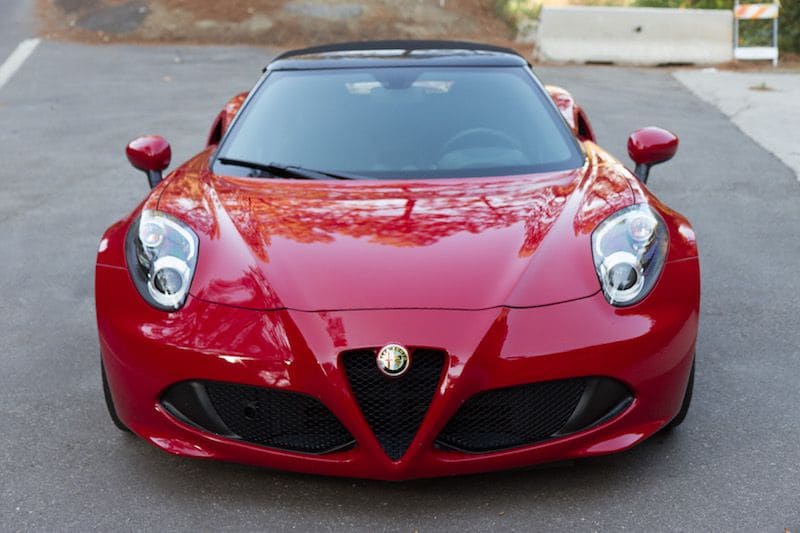
2016 Alfa Romeo 4C ・ Photo by Jason Fogelson
The 2016 Alfa Romeo 4C Spider washes in with the first wave of new Alfa Romeo vehicles to land on US soil since 1995, following closely upon the launch of the 4C Coupe. A mid-engine/rear-drive monocoque exotic vehicle, the 4C Spider makes no excuses. The affordable supercar seats two, corners like a roller skate, howls like a banshee, and accelerates like a scalded panther. Alfa has married high style with raw technology, resulting in a true driver’s car. Comfort takes a back seat to function -- and there is no back seat. Test driving the 4C revealed strengths and weaknesses, beauty and ugliness -– a dichotomy of sensations and impressions that added up to a unique and challenging automotive experience.
Since 1910
The company that would become Alfa Romeo formed in 1910 as “Anonima Lombarda Fabbrica Automobili” (Lombard Automobile Factory, Public Company), or “A.L.F.A.” A merger of sorts with Nicola Romeo and Company followed in 1918, giving birth to Alfa Romeo. In 1986, Alfa Romeo sold to the Fiat Group. Economic downturns in Italy and a changing automotive landscape in the United States led to Alfa Romeo’s retreat from the US in 1995. When Fiat, under the control of Sergio Marchionne, purchased Chrysler Group to form Fiat Chrysler automobiles (FCA) in 2009, Alfa found itself in a large family of brands that included Italian marques Ferrari, Maserati, Fiat and Lancia, along with American makes Chrysler, Dodge, Ram, SRT, and Mopar.
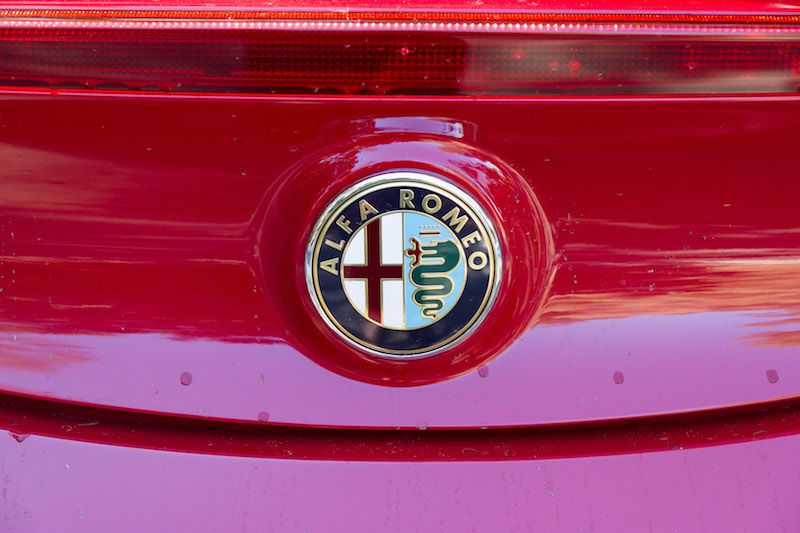
Photo by Jason Fogelson
Monocoque Platform
A monocoque chassis underlies the 4C. A monocoque is a chassis where the body’s structure is made up of the body panels and floor pan (as opposed to body-on-frame, in which the body and powertrain are bolted to frame rails). Much like a supercar, the 4C has a tub-style chassis made from carbon fiber, aluminum and other lightweight materials. The resulting structure has amazing strength and rigidity. The engine sits in the middle of the body, ahead of the driven rear wheels. You access the engine via a rear decklid, which also covers a small (1.3-cubic foot) storage compartment. The front hood can be only opened from underneath by removing some screws and gaskets, something owners shouldn’t attempt.
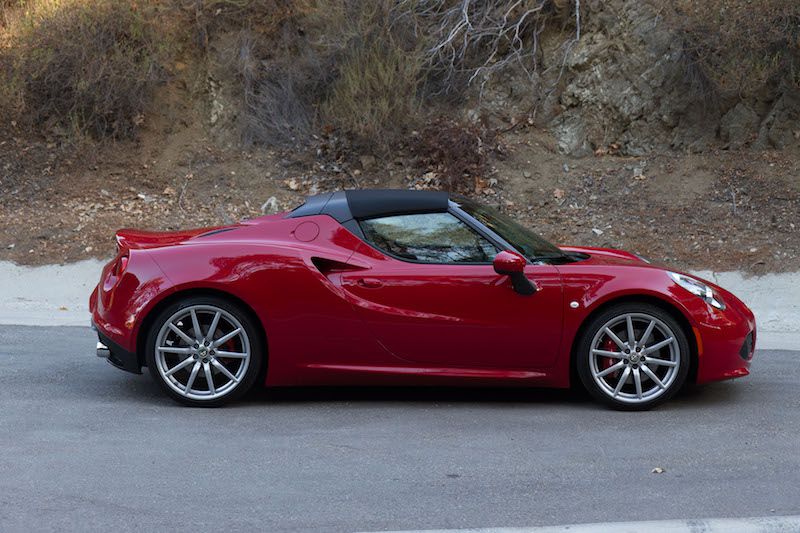
Photo by Jason Fogelson
Design
Up front, a big shield-shaped opening, a historic Alfa feature, wears the company’s badge. Two big openings flank the shield at the bottom of the front fascia. Projector-style halogen headlights (bi-xenon available sit on top of the fenders, completing the 4C’s expressive face.
A character line in the door swoops up to form engine air intakes just behind the cockpit. The back deck, slightly higher than the low front hood, conceals the engine and ends in a brief spoiler. Big round taillights give a retro touch to the rear. The wheels have been pushed to the corners of the vehicle, leaving short front and rear overhangs. The sum total of design results in a gorgeous, low, wide exotic sports car.
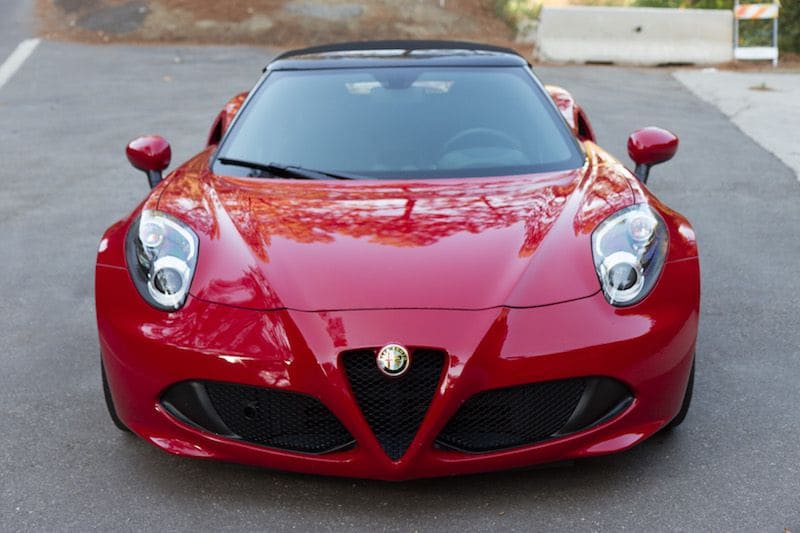
Photo by Jason Fogelson
Comfort and Convenience
The 4C’s interior leans more toward racecar than luxury vehicle, which means comfort takes second place to function. The bolstered racing seats leave much to be desired, especially for American-sized physiques. The tight driver’s footbox forces an uncomfortable angle on the left ankle, and the passenger footbox’s front wall is bare metal. The sound system consists of an Alpine head unit, rather than the integrated units we’ve come to expect, and uses ungainly hanging wires for USB and AUX connections. There’s no glove compartment, just a small square covered cubby tucked between the seats.
Despite these quibbles, the interior’s fit and finish is good. Carbon-fiber trim, real metal and leather surfaces, and tight tolerances impress.
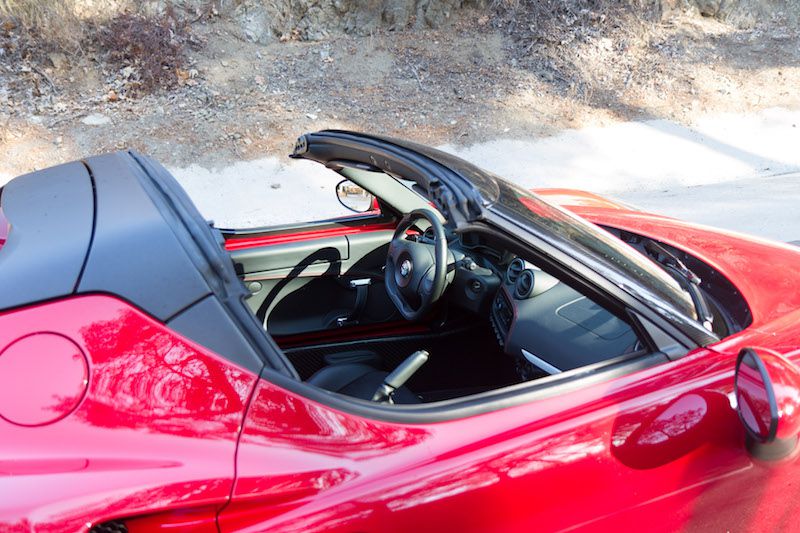
Photo by Jason Fogelson
Features and Controls
The monocoque chassis allows Alfa Romeo to eliminate the cockpit roof without sacrificing structural rigidity. In just seconds, the simple cloth Targa-style cover can be removed and stored in the trunk for open-air motoring.
The cockpit features a center stack canted toward the driver. Round vents sit above the stereo and a row of toggle switches. Beneath that, three simple rotary dials execute climate control.
The center console houses four transmission mode buttons, the “DNA” selector, power window switches, side mirror controls, hazard light switch, a pair of cupholders, and a hand brake.
A single multifunction 7-in. color thin-film transistor (TFT) screen acts as the instrument panel, lurking beneath a round hood directly above the flat-bottom steering wheel.
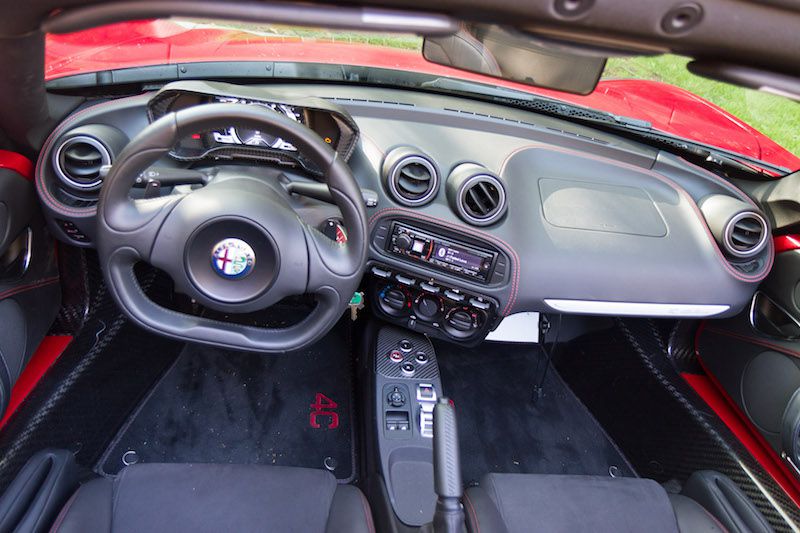
Photo by Jason Fogelson
Transmission and DNA
The 4C’s rear-wheel-drive setup uses a 6-speed automatic/manual dual-clutch transmission. Depress “N” and turn the key to start the engine, then engage “R” to back out. Press “1” to put the transmission in Drive, and the 4C defaults to automatic shifting. Pressing “A/M” toggles between automatic and manual modes. Paddle shifters (“-“ on the left/”+” on the right) actuate shifts in either mode.
The “DNA” mode selector has four settings. The car defaults to “N” for “Natural” each time it restarts. “D” for “Dynamic” delivers dramatically sharper throttle response and shifting. “A” for “All-Weather” softens responses for inclement conditions. A deeply nested “R” for “Race” mode with launch control disables some of the traction control and stability control systems.
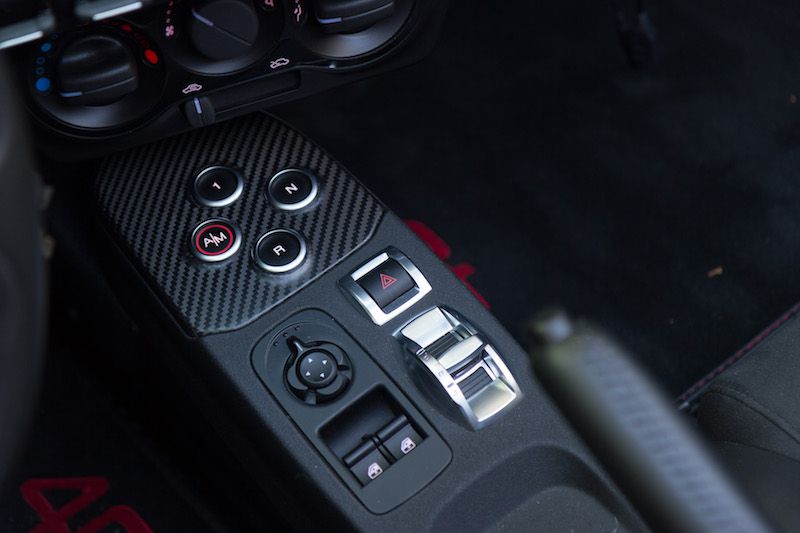
Photo by Jason Fogelson
Engine
Numbers don’t tell the whole story of the Alfa 4C Spider's turbocharged, direct-injected 1750cc 4-cylinder engine. Modest horsepower (237) and torque (258 lb-ft) match perfectly with the 4C’s svelte weight of just 2,487 lb. Compare that to the 2016 Mazda MX-5 Miata, a 2381 lb. car with 155 hp and 148 pound-feet of torque.
In “Natural” mode, the 4C accelerates with authority. Select “Dynamic,” and things get very lively. The exhaust note becomes a throaty growl, and 4C jumps off the line on the way to a 4.1-second trip to 60 mph. “Dynamic” holds the shifts to allow the turbocharger to spool up and remain engaged as the gears go up.
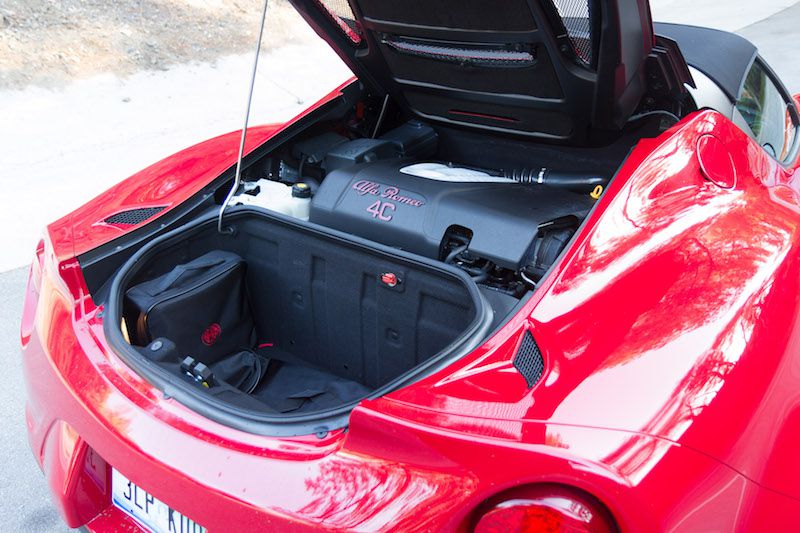
Photo by Jason Fogelson
Handling
It’s hard to beat a well-balanced mid-engine car for handling, especially one with a very low center of gravity like the 4C. Pirelli P Zero tires deliver outstanding grip and road feel. Manual rack-and-pinion steering provides direct response without dartiness or drama. You’ll feel every bump in the road and experience expansion joints as solid thunks, but the tradeoff for a stiff ride is go-kart-like maneuverability. The 4C Spider takes curves like a compass, and holds its line against g-forces when you are deep into the throttle.
If you’ve ever dreamed of owning a vehicle that can do track days, the Alfa Romeo 4C should be high on your list. Public roads cannot throw enough challenges at its capabilities.
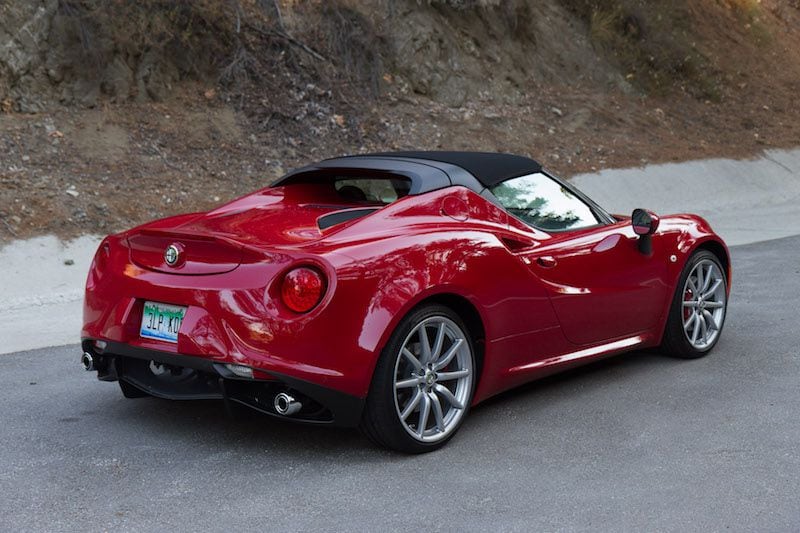
Photo by Jason Fogelson
Fuel Economy and Capacities
Because of its light weight and modest engine size, 4C comes out pretty well on the EPA’s fuel economy tests, at 24 mpg city/34 mpg highway/28 mpg combined. Of course, the EPA testing represents pretty conservative driving behavior, so don’t be surprised if your 4C seems thirstier when you flog it. The 10.5-gallon fuel tank requires 91-octane petrol, and cruising range calculates to 357 miles – but you probably won’t want to drive that far if you don't fit well in those racing seats.
The 4C’s layout and compact cockpit allow for the driver and one passenger, and just one weekend’s worth of clothing will strain the vehicle's scant storage capacity.
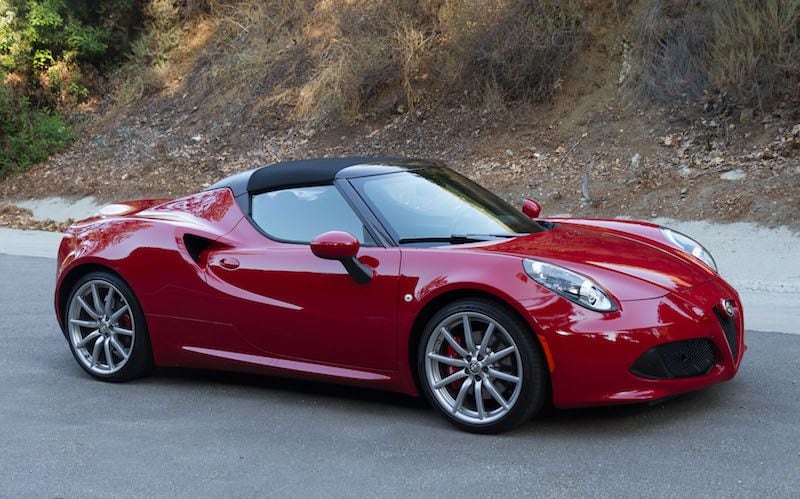
Photo by Jason Fogelson
Final Thoughts
With a base price of $65,900 ($73,995 as tested), the 2016 Alfa Romeo 4C Spider is the most affordable new supercar available. Though far from perfect, this Alfa has incredible character and personality, and it begs to be driven hard. The 4C Spider looks great, sounds great and gets attention everywhere it goes.
If affordability is not an issue, your choice of mid-engine Spider-style sports cars opens up to include the Audi R8 Spyder, McLaren 650S Spider, Ferrari 488 Spider, Lamborghini Huracan Spyder and a few others, the least expensive of which starts at double the 4C’s price.
The 4C makes a compelling argument for Alfa Romeo’s triumphant return to US shores, and it raises hopes for the next wave of sports cars to arrive.

Photo by Jason Fogelson